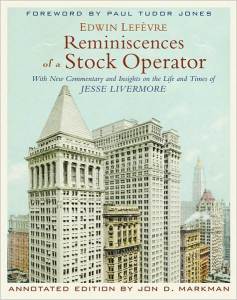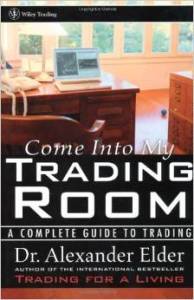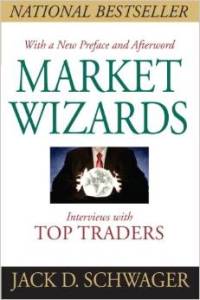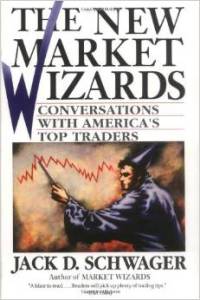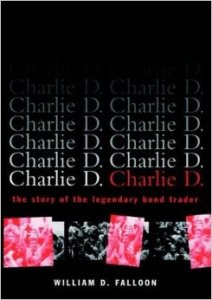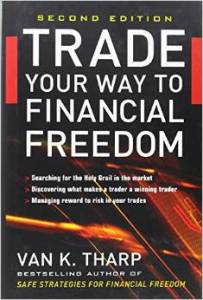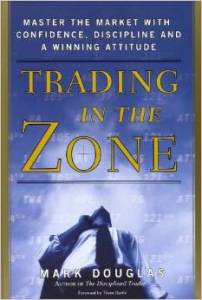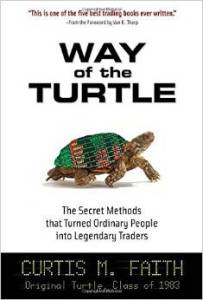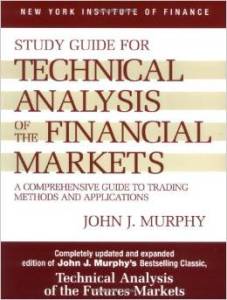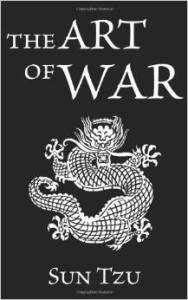 Reminiscences of a Stock Operator (Edwin Lefevre)
Reminiscences of a Stock Operator (Edwin Lefevre)
My dog-eared copy of Reminiscences
An absolute trading classic…
Of all the trading books in all the world, if I had to pick one – this would be it!
It should come as no surprise if you’ve been interested in trading for a while. And if you’re just dipping you toe in for the first time I urge you to go any buy this book right now, you’re in for a treat!
First published in 1923 Reminiscences tells the story of Larry Livingstone – a stock market player and thinly disguised caricature of Jesse Livermore.
Livermore is widely regarded as the greatest trader of all time. He made vast fortunes – worth up to $100 million in the 1920’s – but his weakness was keeping it. He blew-up his account on more than one occasion and was declared bankrupt, later making it all back, and then losing it again!
This book is THE definitive observational account of trading and the financial markets in general. It’s a rollicking story, but it’s also full of trading advice and wisdom. In fact, some traders make a point of re-reading this book every year and they say they learn something new every single time. Even the old-timers who have been trading for decades!
And could it be true Livermore wrote the bulk of the book himself but gave journalist Lefevre full credit? Who better to learn from than the master himself?
There’s a lovely new hardback edition too. It’s expanded with period photos of Wall Street back in the day and over 100 pages of new material.
This book gets my very highest recommendation for traders of all experience.
You can find it on Amazon here
[hr]
 Come Into My Trading Room (Dr Alexander Elder)
Come Into My Trading Room (Dr Alexander Elder)
A condense one-stop-shop for an overview of the various aspects and considerations of your trading operation.
The book is broken down into 3 parts:-
1. Financial trading for babes in the woods:
– Summary of your initial concerns: what markets are available to trade with their own benefits and pitfalls laid out.
– External barriers to success: things particular to trading that you may not have considered (and can put a serious dent in your plans).
– Your Tools: Equipment & data, the different schools of analysis.
2. The three M’s of successful trading:
– The Holy Trinity of trading: Mind, Money Management, Method.
3. Come into my trading room:
– Organising your inner trader: record keeping, focusing your efforts.
What will this book do for you?
It will serve as your trading primer and reference text during the early stages of your trading education.
It identifies and makes you fully aware of the components of your forthcoming trading success – things that will be covered in greater detail in books specialising in each individual aspect further down this list.
You can find it on Amazon here
[hr]
 Market Wizards (Jack Schwager)
Market Wizards (Jack Schwager)
This book contains a collection of interviews undertaken by Schwager in the late 1980’s. It profiles a number of successful traders, many of whom remain big names in the world of trading today. You’ll see some of these characters crop up again further down this reading list as authors of their own books.
Don’t be put off by the age of the book. There is an abundance of relevant information to be absorbed here. The technology may have moved on since the book was written but human nature certainly hasn’t – and what else is a market but an aggregate position of every participating trader’s opinion? Opinion driven mainly by raw greed & fear.
What will this book do for you?
Your subconscious mind will feast on top quality trading nutrients. You’ll be exposed to a huge range of trading styles, markets, first-hand accounts of problems encountered, and solutions found. If you are taking the first steps on your trading journey, try to do a bit of research when you come across new concepts or terminology and build your knowledge as you go.
At low points in your trading campaigns you can take great comfort from the struggles and disasters that these giants of trading had to face and DID overcome.
The Key Laws of Trading found inside this book:
Law #1: All top traders understand that losing is part of the game.
Law #2: Almost all top traders overcome significant obstacles on their path to success. Don’t give up at the first hurdle – the market seems to have a way of testing your mettle before allowing you to progress.
Law #3: Find a trading method that suits your personality. There are many, many different ways to trade – pick one that suits YOU.
You can find it on Amazon here
[hr]
 The New Market Wizards (Jack Schwager)
The New Market Wizards (Jack Schwager)
More of the same… a new set of traders interviewed in the early 90’s.
The Key Laws of Trading found inside this book:
Law #4: Develop monk-like self discipline. It is a prerequisite for controlling risk and it’ll let you apply your trading method without second guessing.
Law #5: Don’t marry your trades – learn to be disloyal. Don’t ignore signs you’re on the wrong side of the market.
Law #6: You can’t win if you HAVE TO win. Scared money never wins. Don’t risk money you can’t afford to lose – your emotions will cloud your judgement.
You can find it on Amazon here
[hr]
 Charlie D – The Story of the Legendary Bond Trader (William Falloon)
Charlie D – The Story of the Legendary Bond Trader (William Falloon)
A personal favourite of mine… the story of a legendary floor trader at the Chicago Board Of Trade.
I traded the 30 year T-Bonds almost exclusively throughout 2005 & 2006 (off the screen). I made a few good contacts on the floor who gave me a heads-up on the gossip and rumours around the pit. These were active traders, one in particular did decent size and they were still TOTALLY in awe of this guy Charlie D – even though he had hot been in the pit for some fifteen years. He sadly passed away in 1991.
What will this book do for you?
It will give you an insight into the makeup of a great trader. Again, you can take comfort in some of the struggles he faces as he begins his trading career – everyone was a beginner at one time, right?
Chapter 6 (God doesn’t trade bonds) is where you will find distilled trading wisdom – a transcription of a lecture given by Charlie D.
The Key Laws of Trading found inside this book:
Law #7: Trading at increased size can only come with time and experience – build up to it.
Law #8: You only need a small edge to make big money.
Law #9: Choose the right instrument to trade. Not all markets will be suitable for your style – there’s no one-size-fits-all.
You can find it on Amazon here
[hr]
 Extraordinary Popular Delusions and the Madness Of Crowds (Charles Mackay)
Extraordinary Popular Delusions and the Madness Of Crowds (Charles Mackay)
After ‘Reminiscences’, this is the next most recommended book by seasoned veterans.
First published in 1841 it takes three examples from history: The Mississippi Scheme, The South Sea Bubble and Tulipomania to show how logic and common sense somehow go out the window when there’s “easy money” to be made.
People risk the financial welfare of themselves and their families by getting into debt just to be able to participate in the speculation – prices rally to dizzying heights fuelled by the buying frenzy until there are no more buyers to be found, even if you wanted to sell out part of your position. Prices start to ease then the panic selling starts as everyone tries to bail out at the same time – prices collapse and national, even worldwide, economic health suffers under the weight of the heavy debts undertaken.
Sound familiar?
If Mackay were still around, a revised edition with a fourth chapter – “The Dot-Com Bubble”, and a fifth – “The Credit Crunch” (not to mention the crashes of 1929 and 1987) would almost be inevitable. As a wise man once said “there is nothing new in the markets”.
What will this book do for you?
It’ll plant firmly in your mind the true reason for market movements – mass psychology and the raw, basic human emotions of greed & fear!
You’ve got to have a snigger at the story of the sailor in the Tulipomania chapter. Whilst on the premises of a wealthy merchant, the sailor mistakes a prize tulip bulb (worth a small fortune at the time) for an onion. He casually slips it into his pocket and slopes off to the quayside to eat it for his breakfast!
The Key Laws of Trading found inside this book:
Law #13: Be aware of the human condition – we are a ‘herd animal’ with a tendency to blindly follow the crowd.
Law #14: Ideas spread quickly – becoming accepted as “truth” too easily.
Law #15: Logical thought and common sense go out of the window when there’s a sniff of ‘easy money’.
You can find it on Amazon here
[hr]
 Trade Your Way To Financial Freedom (Van Tharp)
Trade Your Way To Financial Freedom (Van Tharp)
We’re getting into the real technical areas of successful trading now. Trade Your Way to Financial Freedom is widely known as your definitive reference text for money management.
Van Tharp was one of the people interviewed by Jack Schwager in Market Wizards and needs little more introduction.
What will this book do for you?
It will move your focus away from trying to find the latest “magic entry signal” (a fool’s errand) and onto a key foundation stone of trading – Money Management.
Chapter 6 – “Understanding Expectancy” demands your full attention – it will give you a huge shove in the right direction.
The Key Laws of Trading found inside this book:
Law #16: Forget trading for accuracy – trade for expectancy
Law #17: Know the size of your edge…
Trading Edge = (PW X AW) – (PL X AL)
…where PW is percentage of winning trades, AW is the average amount won, PL is percentage of losing trades and AL is the average amount lost.
Make the calculation. Is your edge positive or negative?
Law #18: Expectancy and probability of winning are not the same thing. People have a bias to want to be ‘right’ on every trade, they tend to gravitate to high-probability entry systems yet these often result in losses and negative expectancy
You can find it on Amazon here
[hr]
 Trading In the Zone (Mark Douglas)
Trading In the Zone (Mark Douglas)
This caters for the psychological aspects of your trading.
Trading is simple but far from easy. What? You just buy low and sell high right?
Nice in theory but we, as humans, seem hard-wired to act against our best interests in the trading arena. What generally works as an act of self-preservation in the outside world tends to have the opposite effect in the markets.
What will this book do for you?
You should not underestimate the ongoing task of getting the correct mindset in place and keeping it there. Mark Douglas is the man to help you do it.
His analogy of learning to trade an edge like a casino made a huge impact on me personally and I would urge you to take the time to get this train of thought firmly installed.
The Key Laws of Trading found inside this book:
Law #19: Observe yourself. Start taking note of what you think, say, and do. Becoming consistent is psychological in nature – you need to pay attention to your mental processes.
Law #20: You need to create the belief you’re a consistent winner. Here are the building blocks to create that belief…
i. I objectively identify my edges
ii. I predefine the risk of every trade
iii. I accept the risk, or I’m prepared to let the trade pass by
iv. I act on my edge without hesitation
v. I pay myself as the market makes money available to me
vi. I monitor my susceptibility for making errors
vii. I accept the absolute necessity of these principles and never violate them
Law #21: Learn to trade an edge like a casino. From a probabilities perspective – you, as a trader, can be the casino, own the game, and be a consistent winner if:
a) You have a genuine edge that puts the odds of success in your favour
b) You can think about trading in the correct manner i.e.
– Anything can happen
– You don’t need to know what’s going to happen next to make money
– There will be a random distribution between your wins and your losses
– Your edge just means there’s a higher probability of your overall campaign making money
– Every moment in the market is unique
– You can do everything you need to over a series of trades
You can find it on Amazon here
[hr]
 Way Of The Turtle (Curtis Faith)
Way Of The Turtle (Curtis Faith)
There was a famous bet made between two traders – Richard Dennis (see Market Wizards) and William Eckhardt (see New Market Wizards) about whether great traders were born or made.
Richard Dennis claimed “we are going to grow traders just like they grow turtles in Singapore” and the infamous “Tutles” came into being.
Curtis Faith was the youngest of the Turtle trainees, he traded the largest account making more than $30 million in just over four years – this is the story of what went on behind the scenes and exactly what the Turtles were taught.
What will this book do for you?
This book gives you the “method” component of this fast-track reading list, you will be given the exact step-by-step method the Turtles followed as well as Faith’s own perspective on trading strategy. You will be left in no doubt as to what needs to be taken into account when formulating your own total trading plan.
The Key Laws of Trading found inside this book:
Law #22: Trading is not a sprint – it’s boxing. The market will screw with your head and do anything it can to defeat you. At the end of round twelve, you must be left standing in the ring in order to win
Law #23: Make sure your system contains all the required components:
i. Markets – what to buy or sell
ii. Position Size – how much to buy or sell
iii. Entries – when to buy or sell
iv. Stops – when to pull the plug on a losing trade
v. Exits – when to rake the chips in on a winning trade
vi. Tactics – how to buy and sell
Law #24: Trading with an edge is what separates the pro’s from the amateurs. Ignore this and you’ll be eaten alive by those who don’t.
You can find it on Amazon here
[hr]
 Technical Analysis Of The Financial Markets (John Murphy)
Technical Analysis Of The Financial Markets (John Murphy)
As traders rather than investors we are typically on the lookout for shorter term opportunities which are highlighted and monitored by the application of “Technical Analysis”.
This is the study of past market data – primarily price & volume – and then the many different studies which are derived from the raw price and volume.
What will this book do for me?
This is is your reference text (read Bible) for the actual job of developing and implementing your selection process of trading opportunities.
You’ll soon start reading different accounts of successful strategies and when you start seeing things like… moving average, relative strength index, candlestick charts, reversal pattern etc… this is the book you’ll turn to for assistance.
You can find it on Amazon here
[hr]
 Art Of War (Sun Tzu)
Art Of War (Sun Tzu)
The Art of War is probably the most famous study of strategy ever written and should be consulted for inspiration and advice in any competitive situation – trading included.
It was first translated by a missionary 200 years ago and is credited with influencing Napoleon, the German General Staff and the planning for Desert Storm amongst others. Of course, it was also immortalised as Gordon Gekko’s literature of choice in the film “Wall Street”!
What will this book do for you?
It will make you analyse your market approach in a unique way. The advice and strategy in the book needs careful consideration and translation into a trading context, you will be pushed to really think hard about things and hold your strategy up to the light – testing its true integrity.
The Key Laws of Trading found inside this book:
Law #25: Assess.
- What do I want to happen – what defines a whole victory
- What advantage do I have – how can I enhance it
- What resources do I need – how can I access them
- What paths lie open to me – which of them appear to have least resistance to success
Law #26: Prepare.
- Preparation is where the battle is won
- Your preparations will tell you whether or not to act
- Prepare, and prepare again, until an acceptable opportunity presents itself
Law #27: Act.
- Choose the most suitable path to your objective
- Focus all your energy on your chosen path
- Deploy all your advantages to assure success
- Achieve your objective intact – do not damage or destroy yourself in the process

